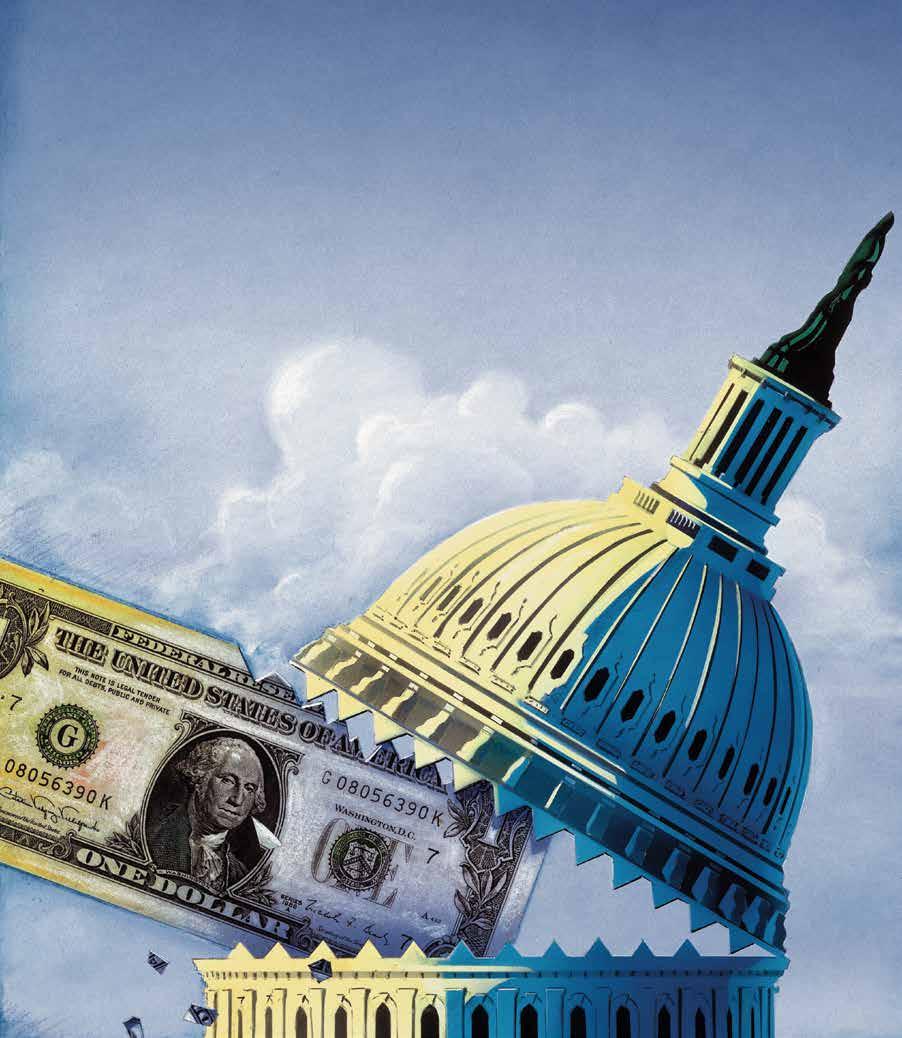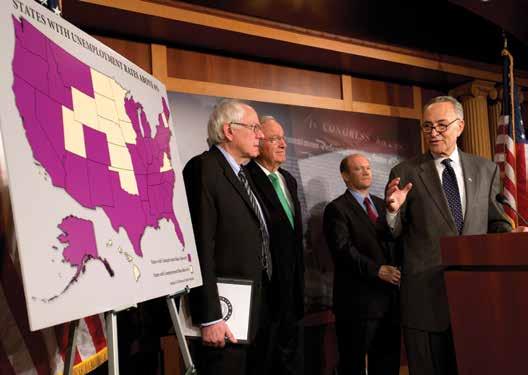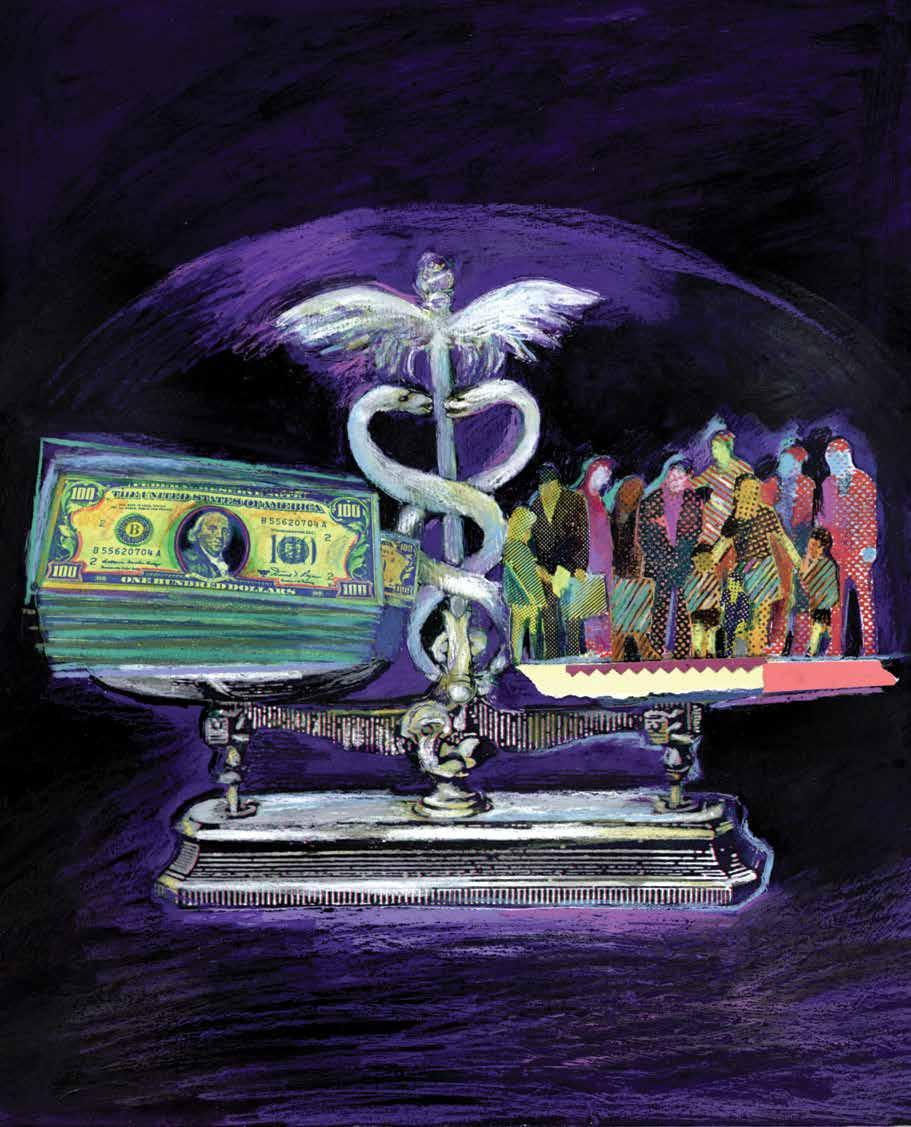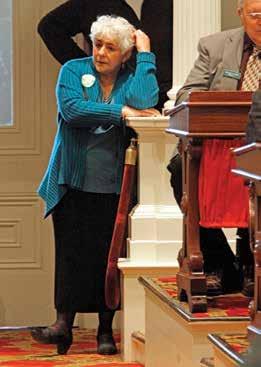
28 minute read
STATE REVENUE VOLATILITY
RICK MATTOON
ABOUT THE AUTHOR Rick Mattoon is a senior economist and economic adviser in the economic research department of the Federal Reserve Bank of Chicago. Mattoon's primary research focuses on issues that face the Midwest regional economy. Mattoon began his career at the Chicago Fed in 1990. He left the bank in 1997, but returned in 2001.
THE U.S. ECONOMY IN 2013: IMPLICATIONS FOR STATE REVENUE VOLATILITY
After economic growth proved slower than anticipated in 2012, the key question most economists have been asking is this: Will growth in 2013 accelerate to a point that the U.S. will begin to make a meaningful dent in unemployment and close other gaps in the economy that emerged after the so-called Great Recession? Most economists expect a stronger level of growth in 2013, but few are calling for real gross domestic product growth of more than 2.5 percent to 3 percent. While this level of growth would certainly help, it would still continue the trend of the economy only slowly returning to pre-recession growth levels. For states, this will likely lead to revenue growth that will be moderate at best.
WHAT PARTS OF THE ECONOMY WILL DO WELL? Manufacturing and agriculture have led the way during the current recovery. A resurgent auto industry and growth in demand for construction and capital equipment kept factories busy and supply chains humming. In the farm belt, high prices for corn and soybeans, as well as livestock, pushed up farm incomes. Farmland values have continued to soar partially in response to these gains. Even in light of last year’s devastating drought, farm incomes have been largely protected through crop insurance. During this time, other sectors of the economy that usually are robust participants in recoveries largely stayed on the sidelines. In particular, real estate—suffering from a glut of supply, foreclosures and financial issues—continued to drag the economy. By the fall of 2012, however, some evidence indicated real estate may have bottomed out and was turning the corner, with limited evidence that prices are actually turning up. If this continues in 2013, it will significantly add to growth prospects.
WHAT KEEPS ECONOMISTS UP AT NIGHT? The threats to better growth in 2013 are significant. A slowdown in Asia’s economies, particularly in China, will dampen demand for many heavy manufacturing products. Continued turmoil in the Eurozone will find negligible growth in European markets. Even if the federal government avoids a fiscal cliff, the continued impact of high federal deficits and likely spending reductions will crimp growth. Local governments continue to feel the impact of declining property values straining local property tax bases.
WHAT WILL THIS MEAN FOR STATE REVENUES? Some recent work that I have done with colleague Leslie McGranahan found that state revenues have become more volatile in responding to national economic cycles since about 2000. Specifically, personal income tax revenues are more than twice as volatile as they were in earlier periods due primarily to changes in personal income dynamics . As nonwage, investment income has grown in importance, personal income tax receipts have tended to exhibit greater boom and busts and are far less predictable. Some of this has been amplified by tax policy choices that often have given favorable treatment to investment income, but most can be accounted for by a higher share of income being derived from investments and other forms of capital gains related income. The issue for states is that it often is up to the individual taxpayer when they choose to recognize these types of income. For example, if investment income is subject to higher tax rates in 2013, it might lead to a rush to recognize investment income in 2012 to avoid the rate increase. Similarly changes in federal tax policy might impact other forms of tax preferences, such as mortgage deductibility, that in turn might change taxpayer behavior.
IN SUMMATION … If some of the headwinds—poor real estate performance, sluggish consumer spending—that have characterized the slow nature of the current recovery can turn into tailwinds, the economy may see a lift in 2013 relative to 2012. However, few predict a sharp upward turn; most believe it will be a gradual acceleration that has legs into future years.
What’s Next for States?
2013 is likely to be better than expected for state budgets, but policymakers still will face challenges. The possibility of expansion for Medicaid, as well as the lingering problems with pensions and unemployment, will garner a lot of attention. Policymakers also will be faced with getting health insurance exchanges operational. States also will feel the cuts in grant funding, if not in 2013, sometime down the road.
12 14 15 16 17 18 20 22 24 26 32
Federal Fiscal Issues Case Study—Revenues Case Study—Medicaid Case Study—Pensions Case Study—Unemployment State Health Exchanges 10 Questions—Mike Allen Elections 2012 By the Book—Federal Financing Federal Budget 101 Straight Talk—Advice to New Legislators
STATE BUDGET OUTLOOK BETTER BUT NOT AS GOOD AS BEFORE
by Mary Branham
When legislators return to their statehouses, the usual suspects of concern will be waiting for them—and some new areas that have been waiting in the wings will rear their heads as well.
States face looming fiscal problems in Medicaid, public pensions and budget gaps, as well as unemployment issues—both in the number of unemployed people who won’t receive benefits after federal extensions end and continued unemployment trust fund insolvency. That doesn’t even touch the problems of funding the everyday services constituents have come to expect.
“A lot of state budget officers are concerned that we will have growth, which is good, but over the next 10 years, the growth will be below normal,” said Scott Pattison, executive director of the National Association of State Budget Officers.
Current spending levels, he said, are about where states were in 2007 before the Great Recession. Most economists thought states’ pre-recession spending levels would return in 2014.
“We’re coming back to pre-recession spending about a year before we thought,” Pattison said.
While that’s good news, the total economic fallout from how the federal government deals with the fiscal cliff could impact states’ bottom lines in the year ahead. The cuts are a concern, Pattison said, but the overall hit to the economy would affect states even more.


State revenues always respond to economic cycles, said Rick Mattoon, senior economist and economic adviser for the Federal Reserve Bank of Chicago.
“As the economy is growing, revenues grow faster,” he said. “As the economy shrinks, revenues decline.”
But federal funding cuts eventually will come, and states must be prepared.
“The consensus is, outside of Medicaid, you’re going to see a lot of grant programs decline—that’s going to have an impact,” Pattison said.
Like the federal government, the biggest drivers of spending at the state level are related to health care. Medicaid spending has spiked in the last few years, although states have gotten it under control in the past year or so—a 3 percent increase versus previous growth of 13.5 percent.
That smaller increase is still a problem, Pattison said.
“You have a huge part of your budget growing faster than the amount of money you have coming in,” he said. “I’ve had budget directors say they’re thrilled that Medicaid slowed to a 4 percent growth, but their budget was growing at 2 percent so all their new money is still going to Medicaid.”
That will keep funding levels for every other program—except, possibly, K–12 education—flat, Pattison said.
States face another problem as Congress tries to address funding at the federal level.
“We’ve got this great big red bull’s-eye on us,” Barry Anderson, deputy director of the National Governors Association, said during The Council of State Governments’ 2012 National Conference.
That’s because of the top 10 tax breaks the federal government offers, two provisions that benefit states rank number two in cost. Those benefits—the deductibility of state and local income, sales and property taxes, as well as the exclusion of interest on public purpose state and local bonds—will likely be targeted by federal lawmakers.
Anderson said those provisions are unlikely to get preferential treatment over things like exclusion of employer payments for health
BUDGET DEALING
SPRINGFIELD, Ill.—Illinois Budget Director Jerry Stermer, shown at the state Capitol in May, told the House Revenue and Finance Committee the governor wants to work with lawmakers on a refinancing plan to pay down some of the state's $8 billion in overdue bills.

© AP Photo/Seth Perlman, File
insurance, which is the top tax break, or even deductibility of mortgage interest on owner-occupied homes, at number three, and deductibility of charitable contributions, at number eight.
NGA is stressing to Congress that states need to be at the table when changes to tax breaks are discussed. Anderson hopes Congress will consider these expenditures in the aggregate, not on an item-by-item basis when looking for deficit reduction.
“Don’t put balancing the budget on the backs of state and local governments,” Anderson said. “It’s a shared thing and we can help, but you (Congress) have to involve us in the process.”

Here’s a look at four major fiscal issues states will be facing in 2013, as well as the top 5 issues in various policy areas.
TOP 5 Policy Issues
Education
» College- and Career-Readiness » Assessment and Accountability » Preparing Teachers and School Leaders » College Completion and Degree Attainment » Postsecondary Education Funding Options
Energy and Environment
» The Future of Coal » Clean Water Act Legal Action and States » Energy Infrastructure » Effectively Managing the Energy Wave » EPA Air Regulations

Fiscal and Economic
» Fiscal Threats from Above » Slow Revenue Recovery—but Recovery » Medicaid » Current and Retired Employee Health Care Costs » Rethinking Economic Development
Health
» Medicaid: Affording the Programs States Already
Have in Place » Medicaid: Expanding Eligibility to 138 % of
Federal Poverty Level » Health Insurance Exchanges » Health Workforce Adequacy » Promoting Healthy Behaviors

Transportation
» Implementation of MAP-21 » A Post-MAP-21 Game Plan for Financing
Transportation » State Governments Seeking New Revenues for
Transportation » Preparedness for the Panama Canal Expansion » Convincing a Skeptical Public
[ REVENUES ] Slower, but More Stable, Growth
Arizona Rep. Russ Jones thinks the “new normal” for state revenues may not be so bad.
“It’s an old adage that when there’s a boom, there’s a bust,” he said during The Council of State Governments’ 2012 National Conference. “The bigger the boom, the bigger the bust.”
The new normal—with more modest but more stable growth rates—“is a lot more manageable for states than the kind of growth we had before and our reactions to it, both good and bad,” he said.
Rick Mattoon, senior economist and economic adviser for the Federal Reserve Bank of Chicago, said the Great Recession put the U.S. economy—and state revenues—on a recovery path different from the past.
“If you have a very sharp downturn, you usually have a very sharp recovery,” Mattoon said. “What we’re getting (now) is a checkshaped recovery; it takes longer to get back to normal.”
By most accounts, the economy is on the upswing of that checkmark.
As such, so are state general fund expenditures, according to Scott Pattison, executive director of the National Association of State Budget Officers. Since 2011, state spending has increased between 2 and 3 percent. While it’s lower than the 35-year historical average of 5.7 percent, it’s still growth and state budget officers are planning for this slower growth over time.
“They’re strategically planning for that instance, which I think is good because then they’re planning more cautiously,” Pattison said. “We’d rather have money be better than expected.”
That’s been the case the past few years.
In 2009, 43 states had to make cuts to their budgets after legislators had passed them and governors had signed them. That dropped to eight states in 2012, and probably two or three in 2013, Pattison said.
While state balance levels are recovering, Pattison said policymakers are spending more cautiously and putting more money into rainy day funds.


“I think this financial decline really spooked state officials and there’s been an incentive to put more money back into the rainy day funds,” he said.
While some debate the decision to build rainy day funds when, as Pattison said, “it’s still raining,” he encourages states to think long-term when budgeting. Think about how a budget decision will affect things five years out, and don’t spend one-time money on recurring expenses, he said.
“States are realizing that if you have money that is one-time only, you spend it on something one-time only,” he said. “If it gets in the base, we’re going to have a real headache putting that budget together in a couple of years.”
Mattoon said putting more money into savings is a good idea. The problem, he said, is that states need a significant amount of money in savings to truly address problems during recessions.
BALANCING ACT
TOPEKA, KAN.—Kansas Gov. Sam Brownback answered questions in October about whether he'll pursue a proposal to help balance the state budget next year with new sales tax revenues.

© AP Photo/John Hanna
The historical amount—5 percent of general fund balance—came from credit rating agencies. It’s enough to make bond payments and isn’t based on fiscal stability, Mattoon said.
“(States) would have to save 20 to 25 percent of fund balance to have a rainy day fund to actually carry them through a significant recession,” he said.
While states are putting more into savings, they’re also still pulling out of the recession. As the two programs that pull the lion’s share of state funding—Medicaid and K–12 education—continue to grow, other programs will see less or stagnant funding.
“We have obligations to spend money on Medicaid and K–12 combined that we just can’t meet,” said Colorado Sen. Greg Brophy.
He pointed out that higher education in his state is funded at the same level as 10 years ago, and he suspects other states are seeing the same kind of thing.
“It’s a tough deal in every state,” he said.
[ MEDICAID ] An Ever-Growing Piece of the Pie
When it comes to budget problems, Medicaid may be the monster in the room.
Not only is it growing faster than other budget areas, but it also faces the potential to gobble up even more state funds. That’s because states will have to decide whether to expand the program for low-income residents as allowed in the federal Affordable Care Act.
If states do expand Medicaid to cover residents up to 138 percent of the federal poverty level, many experts predict people who are eligible now, but not enrolled, will join the rolls. While the federal government will pick up the entire tab for newly eligible enrollees for three years, this woodwork effect will increase Medicaid rolls without the enhanced match rate. Experts expect publicity around the new program will bring in people who haven’t sought Medicaid benefits in the past even though they were eligible. States will receive only their regular match rate for them.
Nearly 20 percent of the population nationwide is enrolled in Medicaid, according to the Kaiser Family Foundation, with total spending in the states ranging from $537.6 million in Wyoming to $52.1 billion in New York for the joint state-federal program.
Scott Pattison, executive director of the National Association of State Budget Officers, pointed out that about 43.5 percent of all funds states get from the federal government go to Medicaid. He expects that number will increase to more than half of federal funding as costs for Medicaid rise.
“That’s really going to change the intergovernmental conversation between the feds and the states,” Pattison said. “It’s going to be really, really focused on health care and less on other areas because that’s where the money is.”
Medicaid is about 24 percent of state budgets, topping K–12 education’s 20 percent, which had always been the biggest percentage of state budgets. K–12 still leads in state general fund spending at 35 percent, Pattison said, but Medicaid has grown to 17.5 percent. General fund Medicaid spending was in the single digits, percentage-wise, 20 years ago.
That fact has states taking a hard look at
MEDICAID DILEMMA
BROOKHAVEN, MISS.—Alvin Hoover, CEO of King's Daughters Medical Center in the small town of Brookhaven, said hospital administrators worry that without Medicaid expansion, they could be saddled with rising costs from treating uninsured patients. ©AP Photo/Rogelio V. Solis


their Medicaid programs and, especially, at the provision in the federal Affordable Care Act that asks states to expand coverage.
Arkansas is changing from a fee-for-service to an outcomes-based system for provider reimbursement, Arkansas Surgeon General Dr. Joseph Thompson said. For instance, now Arkansas pays one fee for a normal pregnancy and birth and tracks outcome data. This replaces the old system where doctors were paid for each service they rendered for a patient, which many experts think leads to unnecessary services and higher costs. “We can’t afford the fee-for-service payment system any more,” Thompson said.
Arkansas hopes those changes will enable it to be able to expand its Medicaid program.
“We don’t believe we should expand Medicaid unless we are changing the payment system concurrently to be able to have an affordable system over time,” Thompson said.
Thompson’s department is combing through every health program to see what can be eliminated if services are covered through expansion of Medicaid.
Texas, meanwhile, is not considering expan

sion, said Dr. Kyle Janek, executive commissioner for Texas Health and Human Services. What Janek would like, however, is broad latitude to design a system specifically for Texas that would allow the state to bend the cost curve.
“The more latitude they can give us, the better system we can develop,” Janek said.
He’ll be seeking waivers from the U.S. Department of Health and Human Services to be able to design a system that works for Texas.
The Pew Charitable Trusts is studying state cost-containment measures that have reduced costs but at least maintained health outcomes. One major measure is Medicaid program integrity, said Matt McKillop, senior associate for research for Pew’s State Health Care Spending Project.
An annual survey found 8.1 percent of total state payments deemed improper; that number has actually been dropping for four years since the federal government began tracking, McKillop said.
“We think—and I think every state would agree—as Medicaid becomes a larger and larger budget item for states, anything above zero is unacceptable,” McKillop said.
[ PUBLIC PENSIONS ] In a Better Place, but Still not Whole
Oklahoma had an unfunded pension liability of $16 billion before the 2011 legislative session.
After the state legislature enacted reforms, the liability fell to $10.6 billion. Much of that drop, Sen. Randy McDaniel said in a Council of State Governments webinar, can be attributed to the fact that any cost-of-living adjustment must be paid for up front.
“By saying you don’t get one or you have to pay for them upfront means that would no longer be unfunded,” McDaniel explained.
Oklahoma is one of 45 states that have made meaningful changes to their public pension plans since 2010. And some that have made changes are facing lawsuits challenging those changes.
While those changes have helped, states still face an unfunded liability for the pension programs for retirees. That means even though those changes are cutting into the unfunded liability levels, states are continuing to look at how to increase solvency for state pension plans.
Keith Brainard, research director for the National Association of State Retirement Administrators, believes the aggregate in public pension funding levels has hit its low mark. Public pensions as a whole were funded at 100 percent in the early 2000s, and dropped steadily to about 76 percent in 2010.
“I think we’ll begin to move upward from here,” Brainard said.
He stressed that there is no national public pension crisis. That doesn’t mean some states and localities don’t have major problems, but some plans are doing just fine, he said.
States began making changes in the midto late-2000s. Among other things, they’re requiring employees to make higher contributions, decreasing benefits by setting a higher retirement age, increasing years of service, lengthening the vesting period, reducing or eliminating cost-of-living adjustments, shifting some risk to employees, and increasing the use of hybrid plans—part defined benefit, part defined contribution.
While many states applied those changes to new hires, some used them on current employees and retirees as well. That’s when the lawsuits come.
Colorado, Minnesota and South Dakota, for instance, reduced COLAs almost simultaneously in 2010. They were met the next day with lawsuits. While two are still in flux, Minnesota won the lawsuit on appeal and was able to make cuts.
That broke ground for such changes, and other states are considering them, Brainard said.
A 2010 Pew Research study, “The Trillion Dollar Gap,” brought renewed attention to the problem. The report concluded state policy choices—such as expanded benefits and free retiree health care—were the chief contributors.
Brainard highlighted another major con
PENSION AND POLITICS
MARION, Ill.—Illinois state Sen. Gary Forby, D-Benton, spoke about jobs growth at the opening of his campaign headquarters in Marion, Ill., in July. Illinois legislators and candidates said voters pressed them for answers about state government’s failure to take control of fast-rising pension costs. The Illinois state pension system has one of the highest unfunded liability levels in the country.


© AP Photo/The Southern Illinoisan, Stephen Rickerl

tributor: “The chronic failure by plan sponsors to make contributions in an adequate and timely manner—that’s really what has gotten some of these funds into trouble.”
Some states are looking into pension obligation bonds to retrofill their required contributions. Brainard said that’s not a bad idea for some. The problem, he said, is that plans that shouldn’t be issuing such bonds are the ones doing it.
Brainard predicts states will continue to try to figure out ways to fix the pension systems, and not just because of the impact to their bottom lines.
“We have a moral, legal responsibility to keep the retirement promises that have been made,” McDaniel said. “Reforms are necessary to achieve this goal.”
[ UNEMPLOYMENT TRUST FUNDS ] An Uphill Battle
State unemployment trust funds—the funds used to pay out unemployment benefits—took a hit during the Great Recession. Sustained high unemployment rates exhausted those funds, and many states borrowed from the federal government to cover their obligations.
By the end of December 2011, 26 states and the Virgin Islands were borrowing money from the Federal Unemployment Account to help pay growing claims for unemployment insurance benefits; outstanding loans totaled more than $36.4 billion, according to a January 2012 Capitol Research brief, “Unemployment Insurance Trust Fund Loans.”
“States in general lowered taxes when times were good, leaving them particularly vulnerable during the recession,” said Jennifer Burnett, economic policy analyst for The Council of State Governments, who authored that report. “Too much demand and too few reserves just strained state resources to the breaking point.”
As the economy has improved, so have the unemployment insurance trust funds in some states. That, said Burnett, can be attributed to state actions to bring solvency back to those funds. Many states raised taxes and cut benefits; some even turned to the private bond market.
South Carolina, for instance, is slowly increasing its taxable wage base to the first $10,000 of a worker’s wages in 2011, to $12,000 in 2012 and to $14,000 in 2014—the first such increases since 1983, according to a report by the South Carolina Department of Employment and Workforce to the General Assembly. The state also changed its tax system for funding unemployment benefits; policymakers now will set new rates each year to ensure the tax schedule raises enough money to fund benefits. The state expects the fund, which became insolvent in 2008, to regain solvency in 2015.
That’s just one example of the changes states are making.
“Digging out of the financial hole will be slow, and costly,” said Burnett.
Many states are still paying back the money
UNEMPLOYMENT WORRIES
WASHINGTON, D.C.—U.S. Sen. Charles Schumer, D-N.Y., right, accompanied by, from left, Sen. Bernard Sanders, I-Vt., Sen. Tom Harkin, D-Iowa, and Sen. Chris Coons, D-Del., in December discussed the possibility of Americans abruptly losing their jobless benefits at the end of 2012. © AP Photo/Jacquelyn Martin


borrowed from the federal government, and now they’re paying billions in interest, Burnett said. Those loans were interest free, but only through 2010.
A Stateline.org article in October said 18 states and the Virgin Islands had paid about $2 billion in interest on those loans as of Sept. 30, 2012. According to the Department of Labor, 19 states and the Virgin Islands still have $26.6 billion in debt on their unemployment trust funds. Among the largest outstanding debt: California, at $10 billion; New York, $3.3 billion; North Carolina, $2.5 billion; and Ohio and Indiana, more than $1.7 billion each.
A 2010 Government Accountability Office report found that a big part of the insolvency problem in unemployment insurance trust funds lay with tax policies and practices in many states.
“While benefits over this period have remained largely flat relative to wages, employer tax rates have declined. Specifically, most state taxable wage bases have not kept

up with increases in wages, and many employers pay very low tax rates on these wage bases,” the GAO report found.
Trust fund solvency isn’t the only issue tied to unemployment that could affect state economies. While unemployment rates have been dropping steadily since July, the national average is still over 7 percent. Some states—like California, Rhode Island and Nevada—all had rates higher than 10 percent in October 2012, according to figures released in November, and long-term unemployment remains stubbornly elevated.
“State leaders have learned a tough, hard lesson over the past few years when it comes to saving and planning for the worst, but those lessons are starting to pay off,” Burnett said. “Fund solvency is beginning to stabilize in many states, thanks to the difficult changes states have made, although the debt accrued during and since the recession will continue to impact some states for the next half decade or more.”
Destination Health Exchange:
A Long Way to Go and a Short Time to Get There
by Mary Branham
Terms to Know }
Essential Health Benefits—This is the core package of services offered in a health plan. The Affordable Care Act requires plans to include 10 essential health benefits: ambulatory patient services; emergency services; hospitalization; maternity and newborn care; mental health and substance use disorder services; prescription drugs; rehabilitative and habilitative services and devices; laboratory services; preventive and wellness services and chronic disease management; and pediatric services, including oral and vision care.

Qualified Health Plan—These plans should provide high-quality coverage like that of a typical employer plan. To be certified by the exchange, health plans must meet minimum standards that are primarily defined in the federal law. Small Business Health Options Program—This program, commonly called SHOP, will provide small employers with new ways to offer employee health coverage, better information, easier administration and access to tax credits that make coverage more affordable. It will allow employers to choose the level of coverage they will offer and offer the employees choices of all qualified health plans within that level of coverage.
Paula Flowers uses lyrics from a popular trucking song to describe the current situation on the establishment of health insurance exchanges.
States, she said, “have a long way to go and a short time to get there.”
Flowers, a former Tennessee insurance commissioner who now works as a consultant, said states can choose from three options under the federal Affordable Care Act—a state-based exchange, a federal exchange or the partnership model—but they’ll all arrive at the starting gate at the same time.
By mid-December, 18 states and the District of Columbia had opted to set up a state exchange, 18 defaulted to the federal exchange and six had opted for the partnership model, according to the Kaiser Family Foundation. That leaves nine states undecided with deadlines approaching fast.
While states may have missed their opportunity to operate a state-based exchange at this point, Chiquita Brooks-LaSure, director of coverage policy for the U.S. Office of Health Reform, said such an exchange is not completely off the table.
“If states are not ready in the first year but want to come in in future years, they certainly have that opportunity to do so,” she said.
But states still have the option of working with the federal government for a partnership exchange if they make the decision soon and
What’s Next }
State-Based Exchanges Jan. 1— The Department of Health and Human Services will approve or conditionally approve state-based exchanges. Conditional ap proval means the exchange is not ready now for operation, but should be ready when enrollment begins. Oct. 1— Exchange Enrollment Period Begins
Jan. 1, 2014— Exchanges are Operational Under this Model— States will manage the exchanges, contract with health plans, provide consumer outreach and assistance and build the IT infrastructure to assess eligibility and enroll people for coverage. They can use federal services to determine eligibility for premium tax credit and cost-sharing programs and to operate the risk adjustment and reinsurance programs. A state-based exchange may determine eligibility for advance payments of the premium tax credit and cost-sharing reductions. States Participating— California, Colorado, Con necticut, District of Columbia, Hawaii, Idaho, Iowa, Kentucky, Maryland, Massachusetts, Minnesota, Mississippi, Nevada, New Mexico, New York, Oregon, Rhode Island, Vermont, Washington submit a blueprint by Feb. 15.
Flowers thinks states, at the very least, should consider the partnership model because it allows states to maintain some control over not only the exchanges, but also other insurance-related issues.
In fact, Brett Graham, a partner with Leavitt Partners, which has a specialty practice on health insurance exchanges, argues that exchanges will not be the decision point on health care in the future—other rules coming out likely will pack a bigger punch.
“As we go forward,” Graham said, “these other insurance reforms are likely to have even more impact on your markets and the cost of insurance in those markets.”
States that defer to a federally facilitated exchange, he said, will have significantly less ability to control many of these other insurance reforms.
On top of that, Flowers said, insurers in each state will prefer some state connection to the exchange.
“Get ready for the hard-court press for a partnership exchange if you didn’t do a state exchange,” she said.
“This is an extraordinary amount of activity that is about to go on in the next eight months,” Flowers said. “It’s going to impact your insurance companies, your insurance regulators, the insurance brokers in your state and you as regulators.”
State-Federal Partnership Exchanges
Feb. 15—States that plan to use the partnership model must submit blueprints to the Department of Health and Human Services.
March 1—The Department of Health and Human Services will begin a rolling approval of partnership exchanges.
Oct. 1—Exchange Enrollment Period Begins
Jan. 1, 2014—Exchanges are Operational
Under this Model—States will manage the exchange with the federal government; it will make it easier for states to transition to a statebased exchange in the future. States can choose to operate certain plan management functions, consumer assistance functions or both. States also can choose to determine eligibility for Medicaid or the Children’s Health Insurance Program or allow the federal government to do so.
States Pursuing Partnership Exchanges—
Arkansas, Delaware, Illinois, Michigan, North Carolina, Ohio
VERMONT EXCHANGE
MONTPELIER, Vt.—Vermont Rep. Joan Lenes, D-Shelburne, listened during debate on steps toward a single-payer health care system for Vermont. Legislators approved a bill to set up a new health insurance exchange—or state marketplace for insurance coverage. © Toby Talbot/ AP/Corbis

Federally Facilitated Exchanges Feb. 15— States that do not submit blueprints for partnership models will defer to the federal government to operate the health exchange in their states. Oct. 1— Exchange Enrollment Period Begins Jan. 1, 2014— Exchanges are Operational Under this Model— The Department of Health and Human Services will assume all primary responsibility for operating the exchange. But the federal government will work to coordinate with state agencies on things such as plan certification and oversight functions, consumer assistance and outreach, and streamlining eligibility determinations for the exchange and Medicaid. This exchange will adopt a clearinghouse model and contract with any health plan that meets all certification standards as a Qualified Health Plan. States Deferring to Federally Facilitated Exchanges— Alabama, Alaska, Arizona, Georgia, Kansas, Louisiana, Maine, Missouri, Nebraska, New Hampshire, North Dakota, Oklahoma, South Carolina, South Dakota, Texas, Wisconsin, Wyoming Undecided States (As of mid-December)— Florida, Indiana, Montana, New Jersey, Pennsylva - nia, Tennessee, Utah, Virginia, West Virginia









